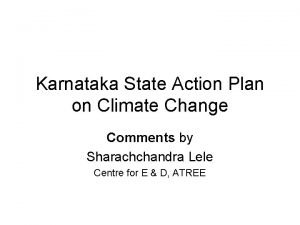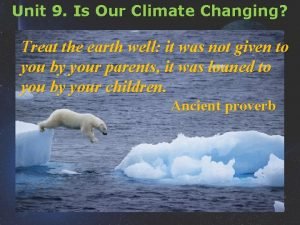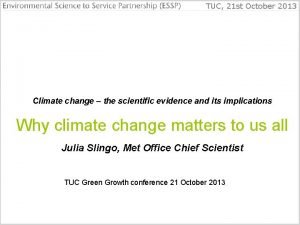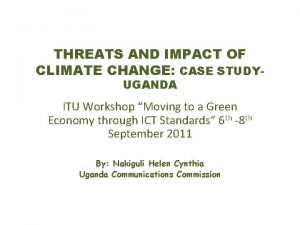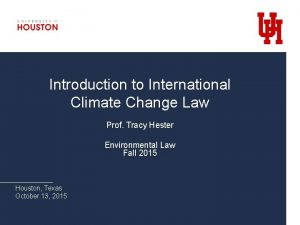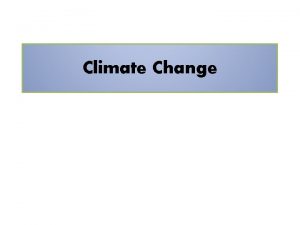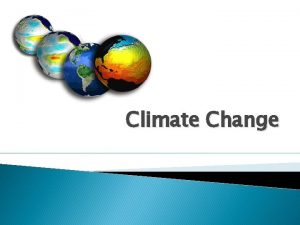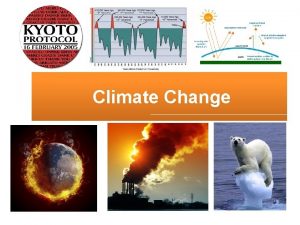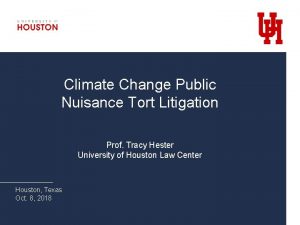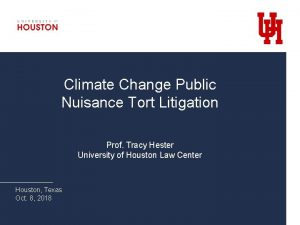Introduction to International Climate Change Law Prof Tracy
















- Slides: 16

Introduction to International Climate Change Law Prof. Tracy Hester Environmental Law Fall 2016 Houston, Texas October 17, 2016



Key International Climate Agreements • U. N. Framework Convention on Climate Change – entered into force in 1994 with 194 signatories, including the United States – Established general goals, including a reduction of current greenhouse gas emissions to 1990 levels to help reduce the risk of disruptive climate change – Tools: common but differentiated responsibilities, precautionary principle • Kyoto Protocol – to date, the only binding international agreement with enforceable emission reduction obligations

UNFCCC’s Shortfalls • Commitments: – All parties: • provide emission inventories (including sinks), • implement national plans to mitigate climate change, and • assist in transfer of technologies – Annex I parties: • adopt national policies to mitigate climate change “with the aim of” returning to 1990 emission levels; • additional funds to developing countries • Problems: – No enforcement – 1990 levels not low enough by scientific consensus

So how did we get here? • What is the Kyoto Protocol? – Technically, the Kyoto Protocol is a supplemental agreement within the U. N. Framework Convention on Climate Change – For many years, it was the most significant international climate change convention that imposed binding emission limits on the nations who ratified it – The Kyoto Protocol established important legal mechanisms to help reduce emissions over time

Canada pulls out of Kyoto Protocol CBC News Posted: Dec 12, 2011 4: 00 PM ET Last Updated: Dec 13, 2011 7: 57 AM ET

Kyoto Protocol • Agreement adopted, after much drama and brinksmanship, on Dec. 11, 1997. Ratified in February 2005 after the Marrakesh Accords and Russian approval (Article 25) • Core concepts: – Targets and timetables for binding emission reduction commitments • Quantified emissions limitation and reduction objectives (QLROs) for Annex I parties (Annex B to Kyoto) – Flexibility mechanisms: joint implementation, emissions trading, Clean Development Mechanism

Kyoto – Flexibility Mechanisms • The Kyoto Protocol provides three flexible mechanisms that Annex I parties can use to meet their emission reduction obligations – International Emissions Trading – Joint Implementation – Clean Development Mechanism • Fundamental question – auction vs. grandfathering?


UNFCCC After Kyoto • Copenhagen Accord 2009 (COP 15) – U. S. , China, Brazil, India and South Africa • Cancun Agreement 2010 (COP 16) • Durban Platform (COP 17) 2011 & Doha Accord (COP 18) 2012 – Rejection of 2 d Kyoto Commitment by Canada, Russia, Japan, New Zealand all developing countries – EU continued with trading system – Commitment to reach new agreement by 2015 • COP 20 – Lima – Green Climate Fund – Differentiated responsibility debate in light of changed emission patterns – Loss and Damage Mechanism


What’s Ahead • The new Paris Agreement and its implementation (Marrakesh) – IDNCs by all parties, including developing nations (China, India) – Earlier bilateral commitments to lay groundwork (U. S. -China) – 1. 5 degree goal – “True up”, disclosure, and continual and review of goals – On way to ratification by required number of parties – The special role and legal posture of the United States • Montreal Protocol expansion to include HFCs • Climate attribution, liability and intervention • Other GHGs and black carbon initiatives



Questions? Professor Tracy Hester University of Houston Law Center tdheste 2@central. uh. edu 713 -743 -1152 (office)
 Climate change 2014 mitigation of climate change
Climate change 2014 mitigation of climate change Newton's first law and second law and third law
Newton's first law and second law and third law Newton's first law and second law and third law
Newton's first law and second law and third law Boyles law
Boyles law P=k/v
P=k/v Climate change paragraph
Climate change paragraph Karnataka state action plan on climate change
Karnataka state action plan on climate change How many major climate types are there worldwide brainpop
How many major climate types are there worldwide brainpop Climate change meaning and definition
Climate change meaning and definition Chapter 13 atmosphere and climate change section 1
Chapter 13 atmosphere and climate change section 1 Unit 9 climate change
Unit 9 climate change Conclusion of climate change
Conclusion of climate change Youreuropemap.com
Youreuropemap.com Conclusion of climate change
Conclusion of climate change Mathematics of climate change
Mathematics of climate change Climate change definition ap world history
Climate change definition ap world history Climate change mitigation
Climate change mitigation






